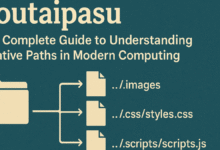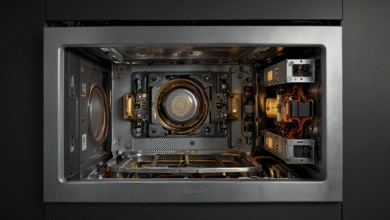Soutaipasu: The Complete Guide to Understanding Relative Paths in Modern Computing

Discover soutaipasu (相対パス), the Japanese term for relative paths. Learn how relative paths work in programming, web development, and file systems with practical examples and expert insights.
The digital world runs on precise navigation, and at the heart of this navigation lies a fundamental concept that Japanese developers call soutaipasu (相対パス). This term, literally meaning “relative path,” represents one of the most crucial yet often overlooked aspects of programming and file management. Understanding soutaipasu isn’t just about learning a new vocabulary word—it’s about mastering a core principle that makes modern software development flexible, portable, and maintainable.
In the rapidly evolving landscape of technology, where applications need to work across different systems and environments, soutaipasu provides the flexibility that absolute paths simply cannot offer. Whether you’re a beginner just starting your journey in programming or an experienced developer looking to deepen your understanding, this comprehensive guide will take you through everything you need to know about soutaipasu and its practical applications.
What is Soutaipasu? Demystifying Relative Paths
Soutaipasu (相対パス) is the Japanese terminology for what English-speaking developers call “relative paths.” At its essence, soutaipasu describes a method of specifying file or directory locations based on the current working directory rather than from the root of the file system. Think of it as giving directions from your current location rather than from a fixed landmark that everyone knows.
The term is derived from the Japanese “相対パス,” and represents a cornerstone idea that enables dynamic, scalable, and context-aware programming. Unlike absolute paths that start from the root directory and provide the complete address to a file, soutaipasu adapts based on where you currently are in the file system. This adaptability makes soutaipasu incredibly valuable in software development, where applications often need to run in different environments without modification.
The beauty of soutaipasu lies in its contextual nature. When you use a soutaipasu, you’re essentially saying “from where I am now, go here.” This approach contrasts sharply with absolute paths, which say “regardless of where you are, start from the beginning and go here.” Instead of spelling out every step (zettaipasu or absolute path), you navigate based on where you already are. This fundamental difference makes soutaipasu an essential tool for creating portable and maintainable code.
The Technical Foundation of Soutaipasu
Understanding soutaipasu requires grasping how file systems organize data and how programs navigate through directory structures. Every file system has a hierarchical structure, much like a family tree, where directories contain other directories and files. When working with soutaipasu, your current position in this tree determines how paths are interpreted.
Soutaipasu refers to file locations described in relation to the current working directory. The current working directory serves as the reference point for all relative path operations. When a program or script executes, it operates from a specific location in the file system, and any soutaipasu used within that program is calculated from this position. This concept is universal across different operating systems, though the syntax may vary slightly between Windows, macOS, and Linux systems.
The technical implementation of soutaipasu involves several key components that work together to resolve file locations. The operating system maintains a record of the current working directory for each running process, and when a soutaipasu is encountered, the system combines this current location with the relative path information to determine the actual file location. This process happens transparently to the user and programmer, making soutaipasu both powerful and easy to use.
Soutaipasu vs. Absolute Paths: Understanding the Fundamental Differences
The distinction between soutaipasu and absolute paths represents one of the most important concepts in file system navigation. While both methods lead to the same destination, they approach the journey very differently. An absolute path provides the complete address from the root directory, leaving nothing to interpretation. In contrast, soutaipasu provides directions relative to your current position, making assumptions about where you’re starting from.
Consider this practical comparison: An absolute path might be /Users/developer/projects/website/images/logo.png on a Unix system or C:\Users\developer\projects\website\images\logo.png on Windows. This path works regardless of where you currently are in the file system, but it’s completely inflexible. If you move the project to a different location or work on a different computer, this absolute path becomes invalid.
A soutaipasu approach to the same file might simply be images/logo.png if you’re currently in the website directory, or ../website/images/logo.png if you’re one level up in the projects directory. The path means: “Go up one directory from the current folder, open the ‘images’ folder, and retrieve logo.png.” This flexibility makes soutaipasu invaluable for creating portable applications and maintaining clean, organized codebases.
The choice between soutaipasu and absolute paths often depends on the specific use case and requirements of your project. Absolute paths provide certainty and precision, making them ideal for system-level operations or when you need to reference files in fixed locations. Soutaipasu excels in scenarios where portability and maintainability are priorities, such as web development, application deployment, and collaborative development environments.
Common Soutaipasu Notation and Syntax
Mastering soutaipasu requires understanding its notation system, which uses specific symbols to represent different types of navigation within the directory structure. These symbols are consistent across most operating systems and programming languages, making them a universal language for file system navigation.
The most fundamental soutaipasu notation is the simple filename or directory name, which refers to an item in the current directory. For example, document.txt refers to a file named document.txt in the current working directory. This is the simplest form of soutaipasu and the one you’ll encounter most frequently in everyday programming.
The forward slash (/) serves as the directory separator in soutaipasu notation, allowing you to navigate through multiple directory levels. A path like folder/subfolder/file.txt instructs the system to look in the current directory for a folder named “folder,” then inside that folder for a subfolder named “subfolder,” and finally locate “file.txt” within that subfolder. This hierarchical navigation is the backbone of soutaipasu functionality.
The dot notation plays a crucial role in soutaipasu navigation. A single dot (.) represents the current directory, while double dots (..) represent the parent directory. The “..” is used to navigate up one level in the directory hierarchy. These symbols allow you to move both down and up the directory tree, providing complete navigational flexibility within a soutaipasu framework.
Soutaipasu in Web Development
Web development represents one of the most common and practical applications of soutaipasu. When building websites, developers constantly reference various resources such as images, stylesheets, JavaScript files, and other HTML documents. Using soutaipasu for these references makes websites more portable and easier to maintain across different environments.
In web development context, soutaipasu is used for linking resources like images, scripts, or stylesheets. Consider a typical website structure where HTML files are in the root directory, CSS files are in a “styles” folder, and images are in an “images” folder. Using soutaipasu, an HTML file can reference a stylesheet with styles/main.css and an image with images/logo.png. These paths remain valid whether the website runs on a local development server, a staging environment, or the final production server.
The portability advantage of soutaipasu becomes especially apparent when working with content management systems or when deploying websites to different hosting environments. A website built with soutaipasu references can be moved from one server to another without breaking any links, as long as the internal directory structure remains consistent. This flexibility has made soutaipasu the standard approach for web development resource management.
Web frameworks and content management systems have embraced soutaipasu as the default method for resource linking. Whether you’re working with React, Angular, Vue.js, or traditional HTML and CSS, understanding soutaipasu is essential for creating maintainable and portable web applications. The concept extends beyond simple file references to include API endpoints, routing configurations, and module imports in modern web development workflows.
Programming Languages and Soutaipasu Implementation
Different programming languages implement soutaipasu support through various mechanisms, but the underlying principles remain consistent across platforms. Understanding how your chosen programming language handles soutaipasu is crucial for effective development and avoiding common pitfalls.
In Python, soutaipasu functionality is primarily handled through the os.path module and the newer pathlib module. These modules provide cross-platform support for path operations, automatically handling the differences between Windows and Unix-style path separators. Python developers can use soutaipasu to import modules, open files, and navigate directory structures in a platform-independent manner.
JavaScript and Node.js provide robust soutaipasu support through the built-in path module and various file system operations. In browser environments, soutaipasu plays a crucial role in module loading, asset references, and AJAX requests. The import and require statements in JavaScript naturally support soutaipasu notation, making it easy to organize code into logical directory structures.
Java handles soutaipasu through the java.nio.file package, which provides comprehensive path manipulation capabilities. When learning to access data files through programming, we regularly use relative file paths in Java examples. The Java approach to soutaipasu emphasizes type safety and cross-platform compatibility, ensuring that applications behave consistently regardless of the underlying operating system.
File System Navigation with Soutaipasu
Effective file system navigation using soutaipasu requires understanding the hierarchical structure of modern file systems and how to move efficiently between different levels of the directory tree. This navigation becomes second nature with practice, but mastering the concepts early will significantly improve your productivity and code quality.
The foundation of soutaipasu navigation lies in understanding your current working directory and how to move relative to that position. When you execute a program or script, it runs from a specific location in the file system, and this location serves as the reference point for all soutaipasu operations. Knowing where you are is essential for effective soutaipasu usage.
Moving down the directory tree using soutaipasu is straightforward—you simply specify the directory names separated by forward slashes. Moving up the tree requires the double-dot notation, which allows you to ascend to parent directories. Complex navigation often combines these elements, creating paths that move both up and down the directory structure to reach the desired destination.
A relative path needs to be combined with another path in order to access a file. This combination process happens automatically when the operating system resolves a soutaipasu, but understanding the mechanics helps you debug issues and create more reliable applications. The resolution process takes your current working directory and applies the soutaipasu instructions to determine the final absolute path to the target file or directory.
Best Practices for Using Soutaipasu
Implementing soutaipasu effectively requires following established best practices that promote code maintainability, portability, and reliability. These practices have evolved through years of collective experience in the development community and represent time-tested approaches to common challenges.
Consistency in soutaipasu usage across a project creates a predictable and maintainable codebase. Establish clear conventions for directory organization and stick to them throughout your project. This consistency makes it easier for team members to understand and modify code, reduces the likelihood of path-related errors, and simplifies maintenance tasks.
Avoiding deep nesting in soutaipasu reduces complexity and improves readability. While it’s technically possible to create paths like ../../../deeply/nested/folder/file.txt, such constructions are error-prone and difficult to maintain. Instead, organize your project structure to minimize the need for complex navigation, and consider using configuration files or environment variables for frequently accessed paths.
Documentation becomes crucial when working with complex soutaipasu structures. Comment your code to explain non-obvious path relationships, and maintain clear documentation about your project’s directory structure. This documentation proves invaluable when returning to code after extended periods or when onboarding new team members to a project.
Common Soutaipasu Errors and Troubleshooting
Understanding common soutaipasu errors and their solutions can save significant development time and frustration. These errors often stem from misconceptions about how paths are resolved or from changes in the directory structure that break existing path references.
The most frequent soutaipasu error occurs when developers assume an incorrect current working directory. This mistake leads to “file not found” errors even when the file exists in the expected location. The solution involves either correcting the soutaipasu to match the actual current directory or changing the current directory to match the expected path structure.
Case sensitivity issues represent another common source of soutaipasu problems, particularly when developing on different operating systems. macOS and Windows’ native file systems are case-insensitive by default, whereas typical Linux file systems are case-sensitive. Code that works perfectly on Windows might fail on Linux due to case mismatches in file or directory names. Maintaining consistent naming conventions and testing on target platforms helps prevent these issues.
Path separator confusion can cause problems when moving code between Windows and Unix-based systems. While most modern programming languages and frameworks handle path separator differences automatically, manually constructed paths might fail when moved between systems. Using platform-independent path construction methods provided by your programming language or framework eliminates these compatibility issues.
Performance Considerations with Soutaipasu
While soutaipasu offers numerous advantages in terms of flexibility and maintainability, understanding its performance implications helps you make informed decisions about when and how to use relative paths in performance-critical applications.
The resolution process for soutaipasu involves additional computational overhead compared to absolute paths. The operating system must combine the current working directory with the relative path information to determine the final file location. While this overhead is typically negligible for most applications, it can become significant in scenarios involving thousands of file operations per second.
Caching strategies can mitigate performance concerns when working with frequently accessed soutaipasu references. Many applications benefit from resolving relative paths once and caching the resulting absolute paths for subsequent use. This approach provides the development benefits of soutaipasu while maintaining the performance characteristics of absolute paths during runtime.
File system cache behavior also affects soutaipasu performance. Modern operating systems maintain sophisticated caching systems that remember recently accessed file locations. Frequently used soutaipasu references benefit from this caching, while rarely accessed paths may require full resolution processing each time they’re referenced.
Security Implications of Soutaipasu
Security considerations become paramount when working with soutaipasu in applications that handle user input or operate in multi-user environments. Understanding potential security vulnerabilities and implementing appropriate safeguards protects your applications from malicious exploitation.
Directory traversal attacks represent the most significant security risk associated with soutaipasu. These attacks exploit the double-dot notation to access files outside the intended directory structure. A malicious user might input a path like ../../../etc/passwd to attempt accessing system files. Proper input validation and path sanitization prevent these attacks by rejecting or modifying dangerous path components.
Path injection vulnerabilities can occur when user input is directly incorporated into soutaipasu operations without proper validation. Similar to SQL injection attacks, path injection exploits trust assumptions about user-provided data. Implementing strict input validation, using parameterized path operations, and maintaining principle of least privilege access controls mitigate these risks.
Symbolic link attacks exploit the way some systems handle symbolic links within soutaipasu resolution. An attacker might create symbolic links that redirect soutaipasu references to unintended locations, potentially exposing sensitive files or enabling privilege escalation. Understanding your platform’s symbolic link behavior and implementing appropriate restrictions help prevent these attacks.
Soutaipasu in Modern Development Workflows
Contemporary development practices have embraced soutaipasu as an essential component of maintainable and scalable software architecture. Understanding how soutaipasu fits into modern development workflows helps you leverage its benefits effectively while avoiding common pitfalls.
Version control systems like Git work seamlessly with soutaipasu-based projects, as the relative path references remain valid regardless of where the repository is cloned. This compatibility makes soutaipasu ideal for collaborative development environments where multiple developers work on the same codebase across different machines and operating systems.
Continuous integration and deployment pipelines benefit significantly from soutaipasu usage. Applications built with relative path references can move through different environments—development, testing, staging, and production—without requiring path modifications. This portability reduces deployment complexity and minimizes the risk of environment-specific errors.
Container technologies like Docker have further emphasized the importance of soutaipasu. Container images built with relative path references remain portable across different hosting environments and deployment scenarios. This flexibility is crucial when working across different environments or systems. The immutable nature of containers makes soutaipasu an natural choice for containerized applications.
Cross-Platform Soutaipasu Compatibility
Achieving cross-platform compatibility with soutaipasu requires understanding the differences between various operating systems and implementing strategies that work consistently across all target platforms. These differences primarily relate to path separators, case sensitivity, and file naming conventions.
Windows systems traditionally use backslashes (\) as path separators, while Unix-based systems (including Linux and macOS) use forward slashes (/). Modern programming languages and frameworks typically handle this difference automatically, converting path separators as needed. However, manually constructed paths require careful attention to ensure cross-platform compatibility.
File naming restrictions vary between operating systems and can affect soutaipasu compatibility. Windows has more restrictive file naming rules than Unix-based systems, prohibiting certain characters and reserving specific filenames. Designing your directory structure and naming conventions to accommodate the most restrictive target platform ensures compatibility across all systems.
Character encoding considerations become important when working with soutaipasu in international environments. Different file systems handle Unicode characters differently, and path names containing non-ASCII characters might behave unexpectedly across platforms. Using ASCII-only path names or implementing proper encoding handling prevents these compatibility issues.
Advanced Soutaipasu Techniques and Patterns
Mastering advanced soutaipasu techniques enables you to create more sophisticated and maintainable applications. These techniques build upon the fundamental concepts to address complex scenarios and optimization opportunities.
Path normalization represents a crucial advanced technique for working with soutaipasu. Normalization resolves complex path constructions like folder/../another/./file.txt into their simplified forms, removing redundant elements and improving both performance and readability. Most programming languages provide built-in normalization functions that handle this process automatically.
Pattern-based soutaipasu operations enable powerful batch processing capabilities. Using wildcards and regular expressions with relative paths allows you to operate on multiple files or directories simultaneously. These patterns prove particularly useful for build systems, file processing applications, and automated maintenance tasks.
Dynamic soutaipasu construction allows applications to build path references programmatically based on runtime conditions. This technique proves valuable when working with user-generated content, configuration-driven applications, or systems that adapt their behavior based on environmental factors. Proper validation and sanitization remain crucial when implementing dynamic path construction.
Integration with Modern Frameworks and Tools
Contemporary software frameworks have built extensive support for soutaipasu operations, recognizing their importance in modern development practices. Understanding how popular frameworks handle relative paths helps you leverage their capabilities effectively.
Build tools like Webpack, Rollup, and Parcel provide sophisticated soutaipasu resolution mechanisms that handle complex dependency graphs and asset references. These tools can trace relative path relationships throughout your project, optimizing bundle generation and ensuring that all referenced resources are properly included in the final output.
Testing frameworks often require special consideration for soutaipasu handling, as tests typically run from different working directories than the main application. Many testing frameworks provide utilities for managing path resolution during test execution, ensuring that relative path references work correctly in both development and testing environments.
Database migration tools and ORM frameworks frequently use soutaipasu for organizing schema files, migration scripts, and configuration resources. Understanding how these tools resolve relative paths helps you organize your database-related files effectively and avoid common deployment issues.
Table: Soutaipasu vs. Absolute Path Comparison
| Aspect | Soutaipasu (Relative Path) | Absolute Path |
|---|---|---|
| Starting Point | Current working directory | Root directory |
| Portability | Highly portable across systems | System-specific |
| Maintainability | Easy to maintain and modify | Requires updates when moved |
| Performance | Slight overhead for resolution | Direct access |
| Security | Vulnerable to traversal attacks | More predictable behavior |
| Usage in Teams | Ideal for collaborative projects | Problematic in shared environments |
| Example | images/logo.png | /Users/dev/project/images/logo.png |
| Best Use Cases | Web development, applications | System administration, scripts |
Industry Applications of Soutaipasu
Various industries have adopted soutaipasu as a standard practice for specific applications and use cases. Understanding these real-world applications provides insight into the practical value and versatility of relative path concepts.
Web development agencies rely heavily on soutaipasu for creating maintainable client websites. Soutaipasu gives you portable, readable, and flexible links that are ideal for development and intra-site references. The ability to move websites between development, staging, and production environments without modifying path references significantly streamlines the deployment process and reduces the risk of broken links or missing resources.
Software development companies use soutaipasu extensively in their continuous integration and deployment pipelines. Applications built with relative path references can be deployed to different environments without modification, enabling automated deployment processes and reducing the complexity of environment-specific configuration management.
Educational institutions teaching programming and web development emphasize soutaipasu concepts as fundamental skills. Understanding relative paths helps students create portable projects that work consistently across different classroom computers and personal devices, facilitating learning and reducing technical barriers to education.
Future Trends in Soutaipasu Usage
The evolution of software development practices continues to reinforce the importance of soutaipasu concepts while introducing new applications and considerations. Understanding these trends helps you prepare for future development challenges and opportunities.
Cloud-native application development has increased the relevance of soutaipasu as applications need to work consistently across different cloud platforms and containerized environments. The stateless nature of cloud applications makes relative path references particularly valuable for maintaining consistency across dynamic deployment scenarios.
Microservices architectures often rely on soutaipasu for configuration management and inter-service communication. As applications become more distributed and modular, the ability to reference resources relatively becomes crucial for maintaining flexibility and reducing coupling between different services.
Edge computing and progressive web applications are driving new requirements for efficient resource loading and caching strategies. Soutaipasu plays a crucial role in these scenarios by enabling intelligent resource prefetching and optimizing content delivery based on user behavior and network conditions.
“Understanding soutaipasu isn’t just about learning a technical concept—it’s about embracing a philosophy of flexible, maintainable software design that adapts to changing requirements and environments.”
Frequently Asked Questions (FAQs)
Q: What does soutaipasu mean in programming? A: Soutaipasu (相対パス) is the Japanese term for “relative path,” which refers to a way of specifying file or directory locations relative to the current working directory rather than from the root of the file system. It’s widely used in programming to create portable and maintainable code.
Q: How is soutaipasu different from an absolute path? A: Soutaipasu specifies locations relative to your current position, while absolute paths provide the complete address from the root directory. Soutaipasu offers greater flexibility and portability, making it ideal for applications that need to work across different environments.
Q: What are the security risks of using soutaipasu? A: The main security risk is directory traversal attacks, where malicious users exploit the “..” notation to access files outside the intended directory structure. Proper input validation and path sanitization help prevent these attacks.
Q: Can soutaipasu work across different operating systems? A: Yes, soutaipasu concepts work across all modern operating systems. However, you need to be aware of platform-specific differences like path separators and case sensitivity. Most programming languages handle these differences automatically.
Q: When should I use soutaipasu instead of absolute paths? A: Use soutaipasu for web development, application resources, collaborative projects, and any scenario where portability and maintainability are important. Use absolute paths for system-level operations or when you need to reference files in fixed locations.
Q: How do I debug soutaipasu-related errors? A: Common issues include incorrect assumptions about the current working directory, case sensitivity problems, and path separator confusion. Check your current working directory, verify file and folder names match exactly, and use platform-independent path construction methods.
Q: Is there a performance difference between soutaipasu and absolute paths? A: Soutaipasu involves slight overhead for path resolution, but this is negligible in most applications. For performance-critical scenarios with thousands of file operations, consider caching resolved paths or using absolute paths directly.
Q: How does soutaipasu work in web development? A: In web development, soutaipasu is essential for linking resources like images, stylesheets, and scripts. It allows websites to remain portable across different servers and environments while maintaining all resource links.
Q: What’s the best way to organize directories when using soutaipasu? A: Maintain a logical, consistent directory structure with minimal deep nesting. Document your organization scheme and establish clear conventions that all team members follow. This makes soutaipasu usage more predictable and maintainable.
Q: Are there any limitations to using soutaipasu? A: Soutaipasu cannot span different disk drives on some systems, and complex relative paths with many “..” sequences can become difficult to maintain. Also, some security contexts restrict relative path usage to prevent directory traversal attacks.
Conclusion
Soutaipasu represents far more than just a technical concept—it embodies a fundamental approach to creating flexible, maintainable, and portable software solutions. Throughout this comprehensive exploration, we’ve seen how this Japanese term for relative paths has become an essential tool in modern programming, web development, and file system management. The power of soutaipasu lies not just in its technical capabilities, but in its philosophy of context-aware navigation that adapts to different environments and requirements.
As software development continues to evolve toward more distributed, cloud-native, and collaborative approaches, the principles underlying soutaipasu become increasingly relevant. The ability to create applications that work consistently across different systems, deployment environments, and team setups represents a competitive advantage that forward-thinking developers cannot afford to ignore. By mastering soutaipasu concepts and best practices, you’re not just learning a technical skill—you’re adopting a mindset that prioritizes adaptability and maintainability in an ever-changing technological landscape.





